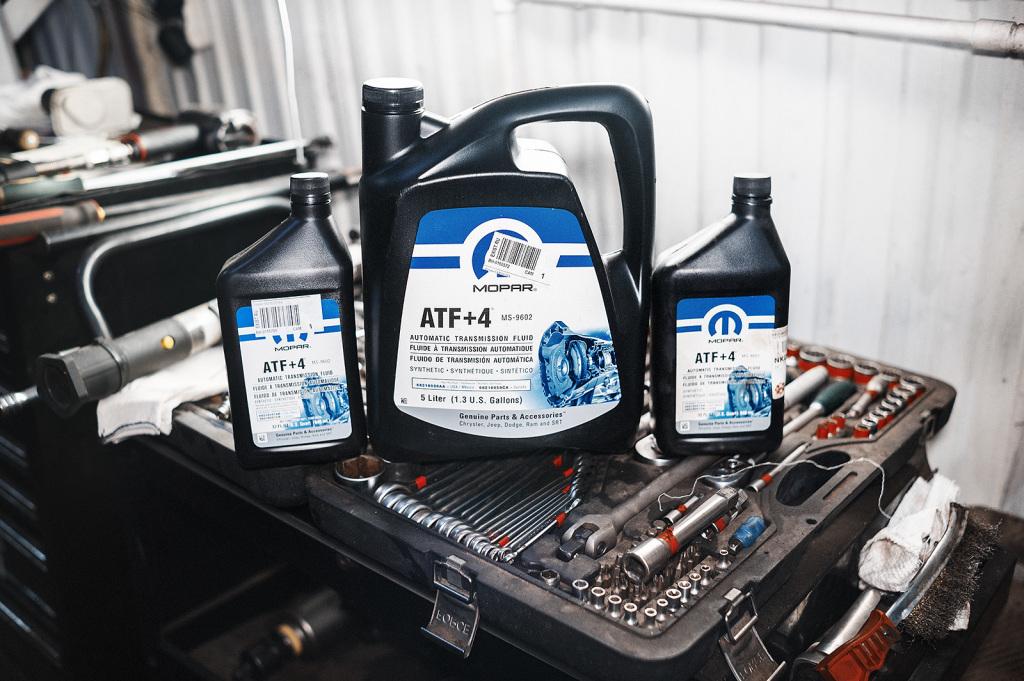
Oil change in automatic transmission: frequency, consumables, work procedure
Content
Changing the oil in an automatic transmission is very different from the same process, but carried out in a manual gearbox: it is impossible to drain the entire volume of the lubricant. Most of the rest is inside the donut, a smaller part in the hydraulic plate and actuators.
Despite the fact that automatic transmissions (hydraulic automatic transmissions) differ in their characteristics, the procedure for changing the oil in an automatic transmission is the same for any transmission of this type. Indeed, regardless of the number of gears and maximum torque, the general principle of operation and the processes occurring in the box are the same.
How is the automatic transmission
This unit consists of the following mechanisms:
- torque converter (GTE or bagel);
- planetary gear set (mounted by one of several planetary type gearboxes);
- selector;
- electronic control unit (ECU);
- hydraulic actuators (cylinders and pistons);
- oil pump and filter;
- clutches;
- brake bands.
GTD
The bagel performs two important functions in an automatic transmission - like a clutch, it partially disconnects the engine from the gearbox shaft and increases torque during the start by reducing the rotation speed.
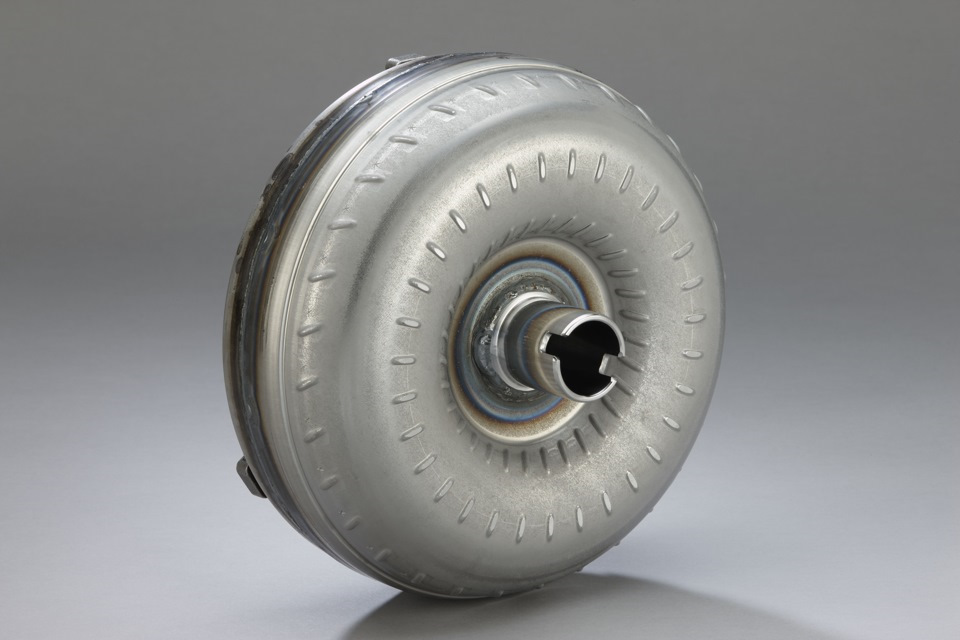
Torque converter automatic transmission
Sensitive to oil cleanliness, but does not affect lubricating fluid performance.
Planetary row
This is the main mechanism of the automatic transmission. Depending on the blocking of one or another gear, the gear ratio changes. Gear ratios are selected to ensure that the engine operates under optimal conditions. It is very sensitive to oil cleanliness, and as it wears out, metal dust and chips get into the transmission fluid.
Selector
This component is located in the passenger compartment and is a multi-position switch with which the driver selects the automatic transmission mode. It is connected to the ECU and has nothing to do with the transmission fluid, therefore it does not depend on its purity and does not affect the condition of the oil.
ECU
This is the "electronic brain" of the transmission. The ECU monitors all parameters of the car's movement and, in accordance with the algorithm sewn into it, controls all the elements of the box. It does not depend on the condition of the oil and does not affect it in any way.
Hydraulic actuators
Hydraulic plate and hydraulic cylinders. They are the "hands" of the ECU and, at the command from the control unit, act on the brake bands and friction clutches, changing the mode of operation of the transmission.
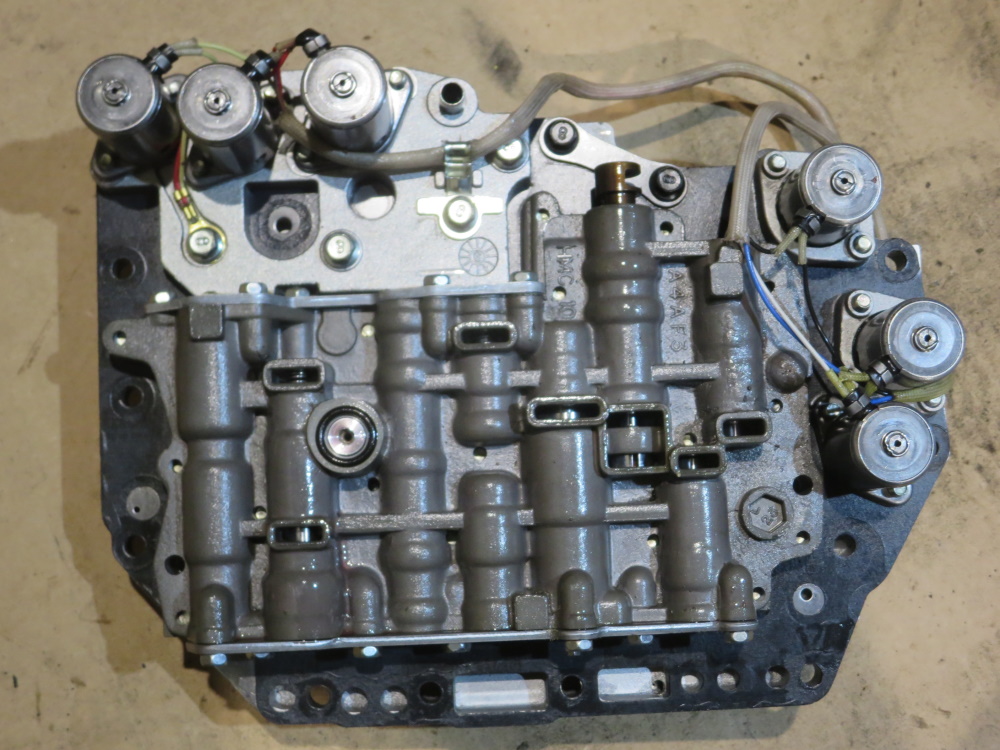
Valve body automatic transmission
Extremely sensitive to the purity of the oil, but do not affect its condition. Even a small piece of soot or metal can block the channel through which fluid enters the hydraulic cylinder, which will disrupt the normal operation of an automatic transmission.
Oil pump and filter
The oil pump is the heart of the gearbox, because it is he who creates the pressure of the transmission fluid necessary for the operation of hydraulic actuators.
Both mechanisms are sensitive to transmission fluid contamination. And an untimely oil change in the automatic gearbox can reduce the throughput of the filter, which will lead to a drop in pressure in the system and a malfunction of the transmission.
Clutches
This is another analog of the clutch in an automatic transmission, making it easier to shift gears and increase the smoothness of this process. They are sensitive to the purity of the oil, and are also its main pollutants. Under heavy load, they overheat the oil, which reduces the life of the transmission fluid and partially changes its main parameters.
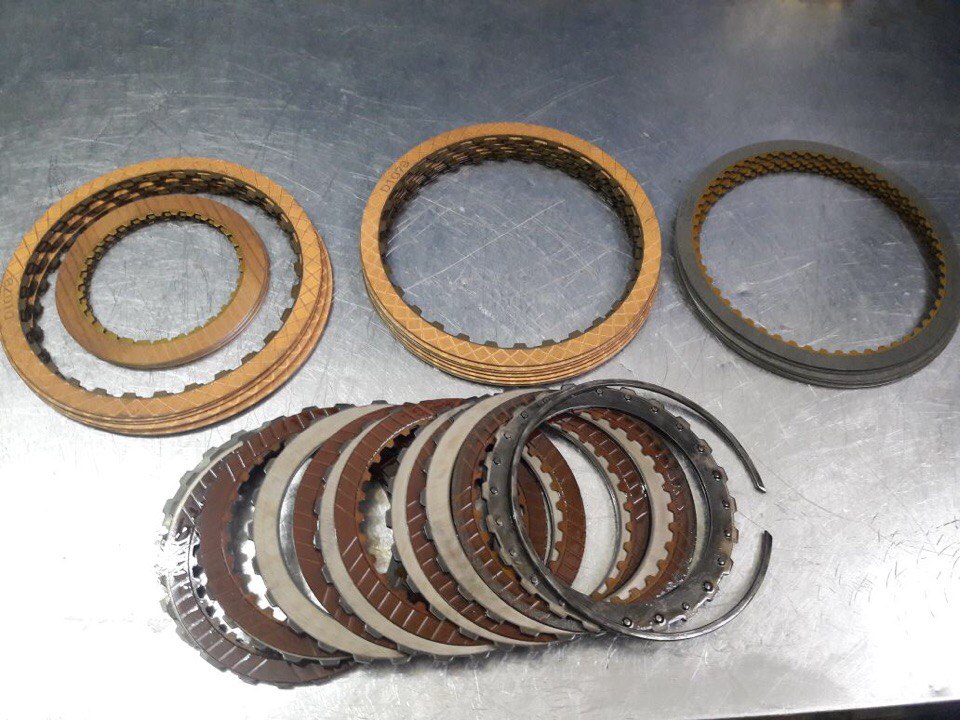
Clutches automatic transmission
Brake bands
They control the planetary series by blocking individual gearboxes, thereby changing the gear ratio, that is, they turn on one or another speed. They are insensitive to contamination of the transmission fluid, and with a long service life or high loads, they wear out, adding metal dust to the oil.
How does automatic transmission work?
When the selector is in the "N" position and the engine is idling, the gas turbine engine transfers only part of the energy to the transmission input shaft, and at a very slow rotation speed. In this case, the first clutch is open, so the torsion energy is not transferred further than it and there is no effect on the wheels. The oil pump creates enough pressure in the system to operate all hydraulic cylinders. When the driver selects any of the driving modes, the hydraulic cylinders that control the brake bands are first turned on, due to which the planetary gear set receives a gear ratio corresponding to the first (lowest) speed.
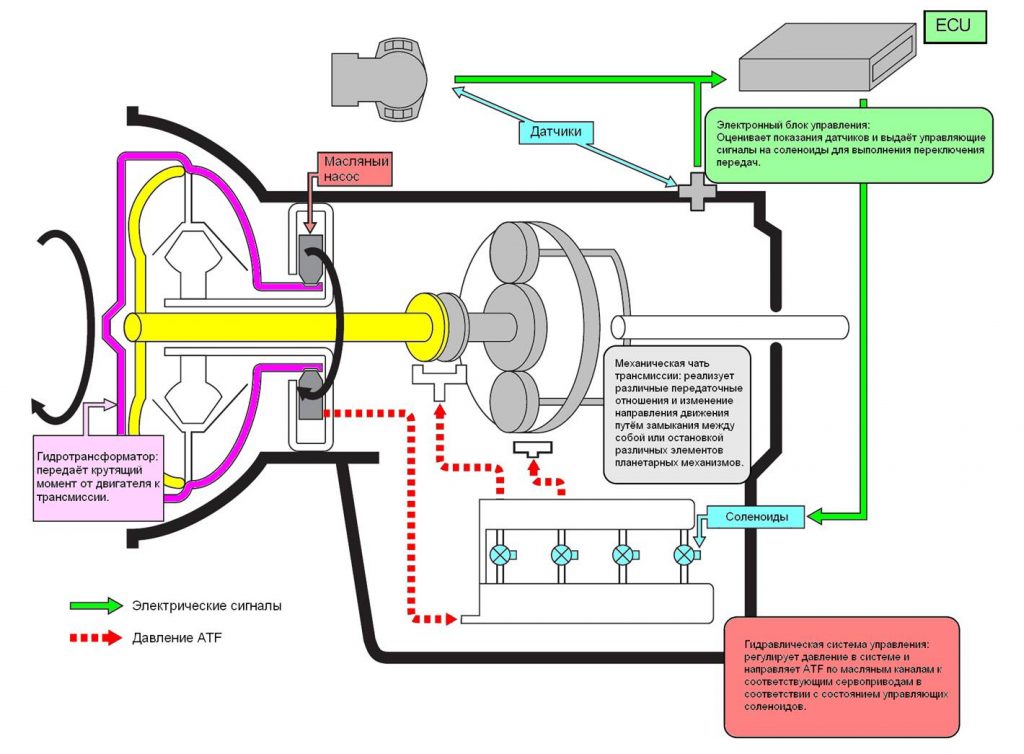
The principle of automatic transmission
When the driver presses the gas, the engine speed increases, then the first clutch is turned on, and the gas turbine engine converts the rotation of the engine shaft, sharply reducing speed and increasing torque. All this, with the correct operation of the box, provides a smooth start of movement and a relatively quick set of speeds.
As the box ECU accelerates, it shifts gears, and opening the first clutch and blocking the planetary gears using brake bands make this process smooth and unnoticeable.
What affects the oil in the automatic transmission
The transmission fluid performs 3 important functions in the box:
- lubricates and cools rubbing elements;
- represents the working body of the torque converter, transferring energy from one part to another;
- is a hydraulic fluid, ensuring the operation of all hydraulic drives.
As long as the lubricant is clean and its parameters are unchanged, all automatic transmission systems work correctly, and the release of soot or metal dust / chips from the box is minimal. As the fluid becomes contaminated and its parameters deteriorate, the following occurs:
- wear of rubbing parts increases, which sharply increases the rate of dirt formation;
- the efficiency of converting the torque of the gas turbine engine is reduced;
- the operation of the hydraulic plate is disrupted, because pieces of dirt clog thin channels and reduce its throughput.
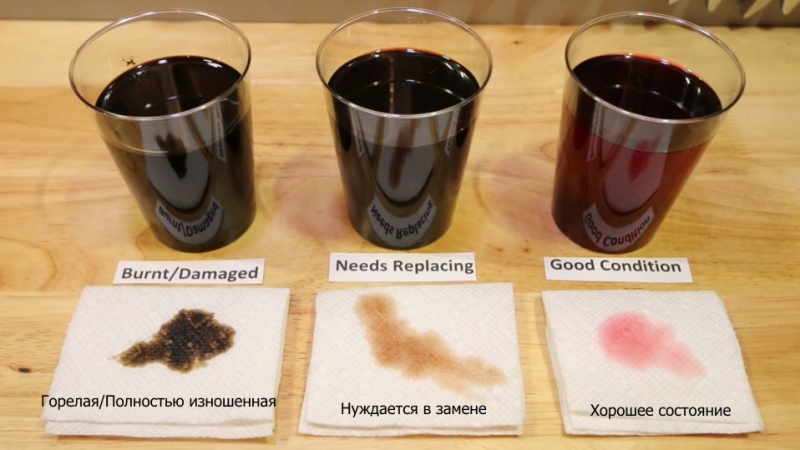
Transmission fluid condition
These processes occur in any automatic transmission. But the stronger its wear, the earlier they begin and pass more intensively. Therefore, the mileage before changing the oil in a new automatic transmission is noticeably longer than in an already tired one.
Change of oil
Changing the oil in an automatic transmission is very different from the same process, but carried out in a manual gearbox: it is impossible to drain the entire volume of the lubricant. Most of the rest is inside the donut, a smaller part in the hydraulic plate and actuators. Therefore, the following types of oil changes are used:
- partial (incomplete);
- double partial;
- full (hardware).
With partial, about half of the liquid is drained, then a new one is added to the required level. The dual method consists in first performing a partial fluid change, then starting the engine for a short time to mix the lubricant, and performing another partial change. This method can replace approximately 70% of the fluid.
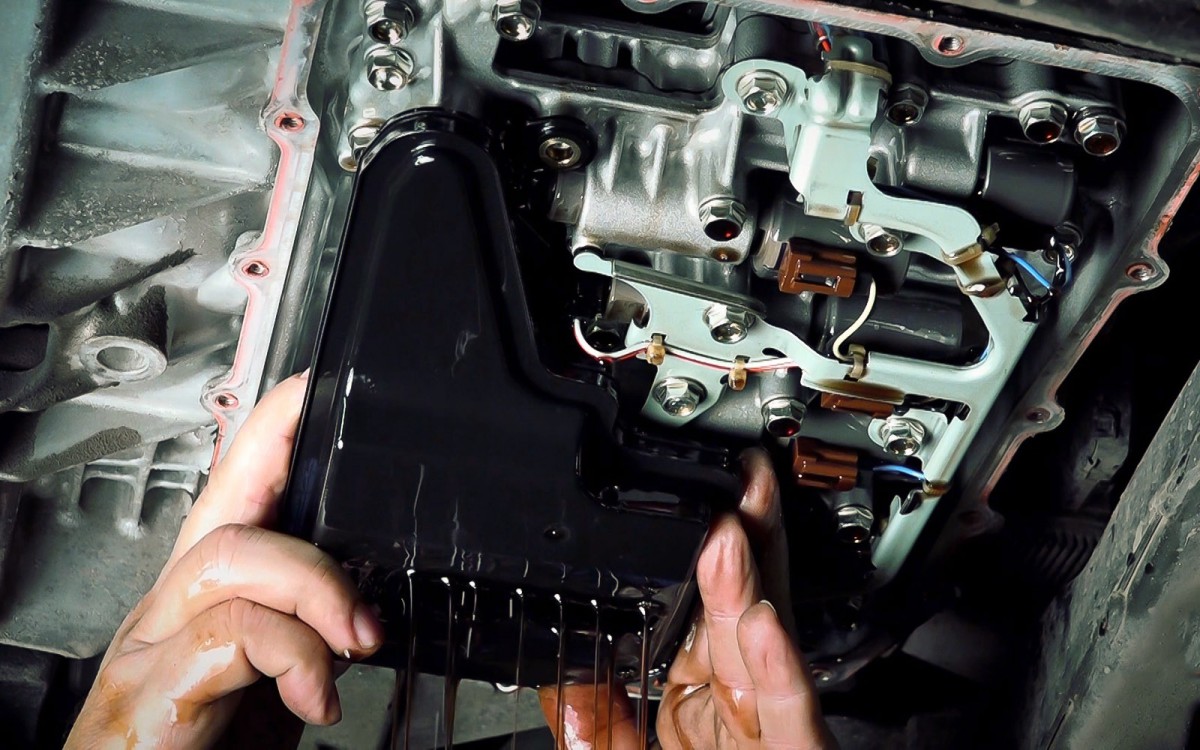
Automatic gearbox oil change
The hardware method allows you to replace 95-98% of the transmission, but it requires a serious intervention in the automatic transmission oil system and a double, and often even triple the amount of new oil.
Partial replacement
This operation is the main one because it includes all basic actions:
- draining transmission fluid;
- filter replacement;
- pallet cleaning;
- oil filling;
- transmission fluid level adjustment.
These actions are called basic because they have to be performed with any method of changing the oil.
Here are the equipment and tools that will be required to perform this operation:
- garage with a pit, overpass or lift;
- a set of open-end and socket wrenches;
- Screwdriver Set;
- passages;
- container for draining mining;
- a syringe or a system for filling a new liquid (you need to select according to the box or car).
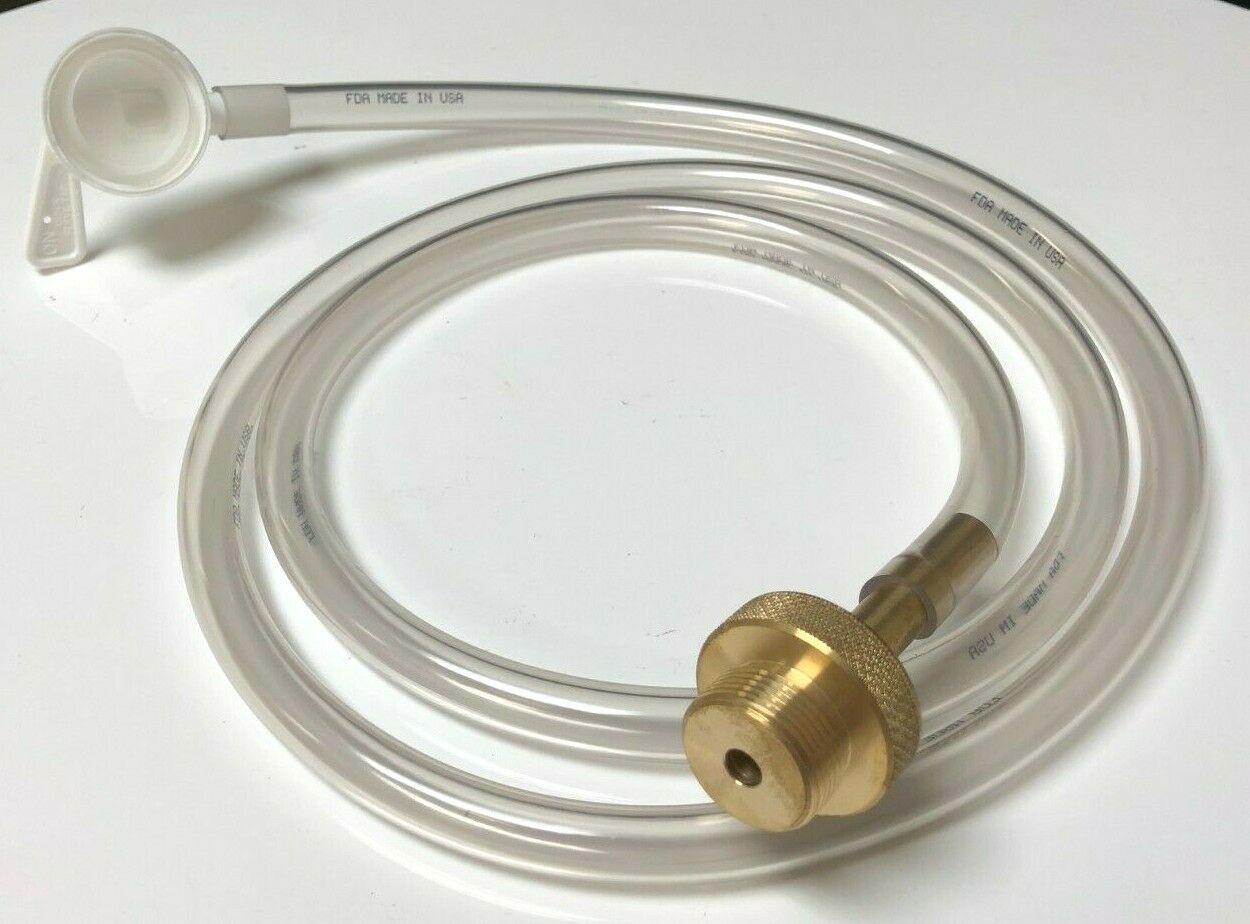
Filling system VAS 6262
This tool and equipment is necessary to work with any automatic transmission.
Procedure
To carry out this procedure, proceed as follows:
- Place the machine on a pit, overpass or lift and support it with wheel chocks.
- Disconnect the battery to protect the engine and gearbox ECU, on some cars it is better to remove it, this will make it easier to access the top of the automatic transmission.
- Free access to the transmission from the side of the hood, this is necessary only in cases where, for some reason, it is more convenient for you to fill in oil from above, for example, through the breather hole.
- Remove the automatic transmission protection, it can be made as one sheet with engine protection, or stand separately.
- Substitute the container and unscrew the drain plug, on some transmissions you will also have to unscrew the measuring tube, without which it will not be possible to drain the oil.
- When the fluid runs out, remove the pan to gain access to the filter and hydraulic plate.
- Change the internal filter. Despite the fact that some masters recommend washing it, we advise you to change it, because the cost of a new element cannot be compared with the damage that a washed filter can cause.
- Replace the external filter if your transmission has one (if not, we recommend installing it, as you will prolong the life of the automatic transmission).
- Replace the gasket and reinstall the pan. Some automakers, such as BMW, do not sell the gasket separately, only with a pallet and new fasteners. Therefore, it is up to you to decide whether to take a substitute, that is, a non-original gasket of unknown quality, or still put what the manufacturer offers.
- Screw in the drain plug, if the box is equipped with a measuring tube, then screw it in first.
- Fill with oil to the correct level. The way to check and adjust the amount of grease depends on the design of the box.
- Replace and connect the battery.
- Start the engine and check the level again, this operation is performed in different ways, depending on the design of the automatic transmission.

Partial oil change in automatic transmission
Reinstall the removed parts.
Double partial replacement
Perform such an oil change in the automatic box according to the algorithm described above. Only after the first replacement, start the engine and let it run for 5–10 minutes so that all the fluid in the automatic transmission is mixed, and also switch the selector lever several times in turn in all positions. Then turn off the engine and change the lubricant again.
Hardware replacement
This method is the most effective, but it should be carried out by a specialist who is well versed in automatic transmissions. For this method, the oil return line is broken and the waste is drained, then the pump is connected to a container with clean transmission fluid and the box is filled with it, washing out the remnants of the old grease. Such washing removes not only mining, but also dirt that has settled in the channels. The method got its name due to the fact that it can be performed only with the help of a special stand (apparatus), and all attempts to get by with improvised means drastically reduce efficiency.
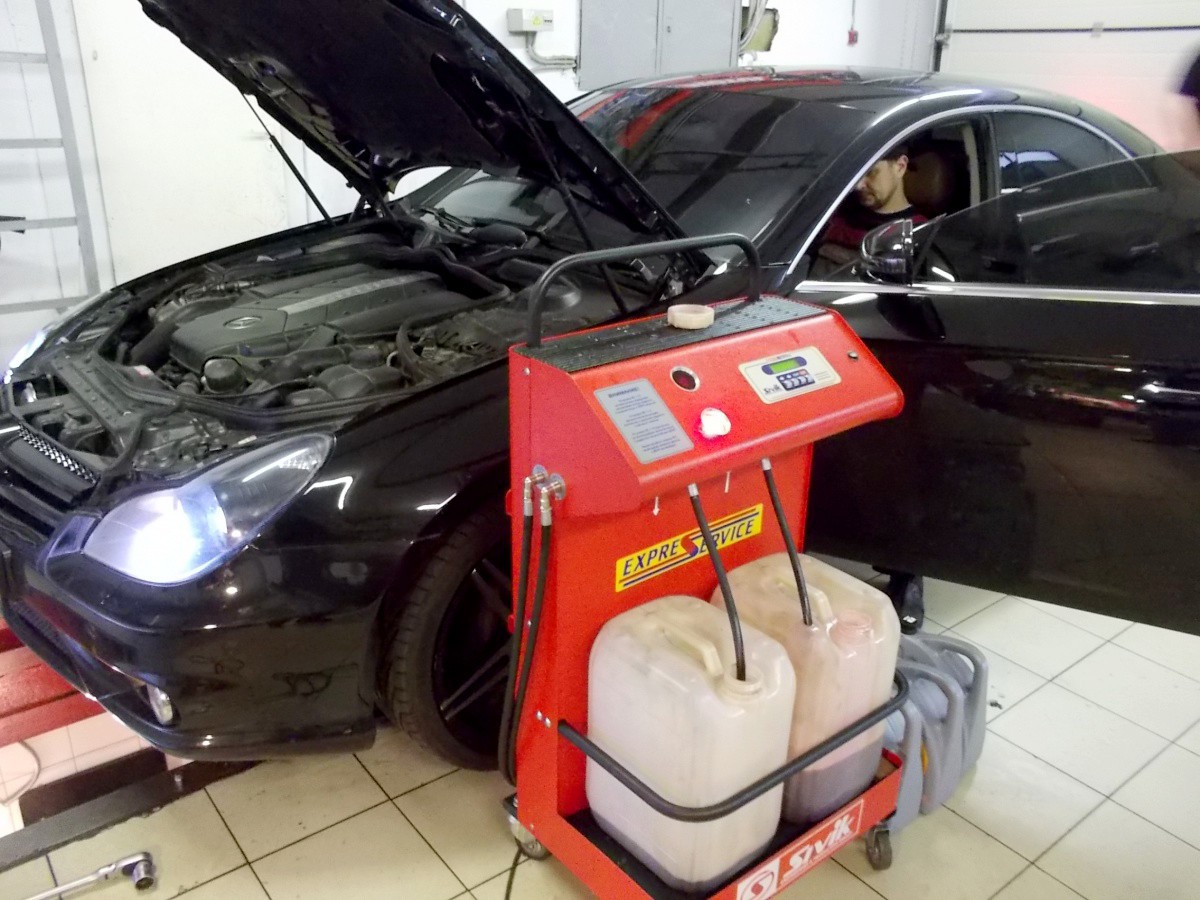
Hardware change of oil in automatic transmission
To completely flush the system, a volume of oil is required that is 3-4 times the standard amount of transmission fluid in the system. After any change of transmission, the box will need adaptation so that the automatic transmission ECU gets used to working with the new oil.
Which method is preferable in different conditions
The choice of the optimal method for changing the oil in an automatic transmission depends on the condition of the unit. If the fluid is clean and the box is working correctly, but according to the regulations, the time has come to change the lubricant (30–60 thousand km), then a partial replacement is sufficient. With a run of 70-120 thousand kilometers, do a double partial fluid change, and when the run is 150-200 thousand, perform a hardware replacement. Then repeat the whole cycle, performing each action with an interval of 20-40 thousand kilometers, until the unit starts to kick or otherwise work incorrectly. With a run of over two hundred thousand, such symptoms indicate the need for repair, regardless of the color or smell of the transmission fluid.

Which way to change the oil in an automatic transmission to choose
Do the same if, with a low mileage (120 or less thousand km), the oil in the transmission is black or emulsified, but there is no strong smell of burning. If, with a small run, it smells strongly of burning, then regardless of the method of replacing it, the unit will quickly require repair. After all, his clutches, and maybe not only them, are very worn out, so they can no longer effectively do their job.
Can you change the oil yourself?
You can replace the transmission in an automatic transmission on your own in the first two ways, that is, partial and double partial. For this, any garage with a pit or overpass is suitable, as well as the usual set of tools used to repair a car. If you yourself perform at least some kind of mechanical repair, then you can handle this task. The main thing is to follow simple rules:
- do not use sealant instead of a regular gasket;
- study the operating instructions for the vehicle and thematic forums where users leave various reviews and comments;
- watch a few videos where an expert shows exactly how to perform a particular action;
- if the protection of the automatic transmission and the engine is made of thick material and is made in the form of a single sheet, then do not carry out the removal alone, ask someone to help you;
- carry out maintenance of the unit, focusing not only on mileage, but also on its condition;
- if you are not sure that you can do everything right, contact a not necessarily specialized, but good car service.
These rules will help you avoid serious mistakes and properly maintain the transmission.
Conclusion
Timely oil change in automatic transmission, as well as proper operation of the car, are the key to a long and flawless service of automatic transmission. The correct choice of the method for performing this operation prolongs the life of not only the automatic transmission, but the entire machine.
